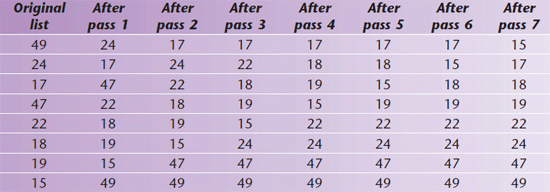Sorting and searching algorithms
After studying this section you should be able to:
- understand algorithms to search for an item
- describe methods of sorting data
- explain how to merge two sets of data
The different types of sort and search
Searching algorithms are used to find an item in a list. The algorithm will be given the key of the item to be found and the search will work through the list looking
for a match.
Sorting algorithms are used to place a list of items into key sequence (either ascending or descending).
Linear search
A procedure to search an ordered list of items for an item can be performed by starting with the first item and proceeding through the list until the item is found.
The search is completed when the item is found or when it comes across an item that has a larger valued key than the required item. An algorithm to search an array
Arr might be:
PROCEDURE LinearSearch(RequiredItem)
Found := false
Failed := false
Current := 1
WHILE (Current <= MaxSize) AND (Found = false) AND (Failed = false)
IF RequiredItem = Arr[Current] THEN Found := true
ELSE
IF RequiredItem < Arr[Current] THEN
Add 1 to Current
IF Current > MaxSize THEN Failed := true
ENDIF
ELSE Failed := true
ENDIF
ENDIF
ENDWHILE
ENDPROC
Binary search
A linear search requires that, on average, half the items will be inspected. A binary search is more efficient. It operates on the principle that the middle item divides the list into two halves. By inspecting the middle item the program can establish which half contains the required item. The algorithm continues by repeating the process on the half that contains the required item. A pseudocode procedure to perform this process is given below.
A binary search is dramatically faster than a linear search when there are a large number of items.
/* Low is the number of the first element in the array and
High is the number of the last element */
PROCEDURE BinarySearch(Low, High, RequiredItem)
Found := False
REPEAT
Middle := Integer part of ((Low + High)/2)
IF Arr[Middle] = RequiredItem
THEN Found := true
ELSE IF Arr[Middle] > RequiredItem
THEN High := Middle – 1
ELSE Low := Middle + 1
ENDIF
ENDIF
UNTIL (Found = True) OR (Low > High)
ENDPROC
Merging
It is often necessary to merge two lists of items. This can only be done efficiently if the lists are both in the same sequence. The algorithm is simpler if terminating values that are larger than any value in the lists are added to the end of the lists before the merge takes place. A pseudocode procedure to merge two lists into a third is as follows:
PROCEDURE Merge(Arr1,Arr2,Arr3)
Current1 := 1
Current2 := 1
Current3 := 1
WHILE Arr1[Current1] is not a terminator
OR Arr2[Current2] is not a terminator do
IF Arr1[Current1] < Arr2[Current2]
THEN
Arr3[Current3] := Arr1[Current1]
Add 1 to Index1
ELSE
Arr3[Current3] := Arr2[Current2]
Add 1 to Index2
ENDIF
Add 1 to Index3
ENDWHILE
ENDPROC
Bubble sort
The bubble sort is not very efficient but it is simple to program and a useful algorithm when there are not many items involved. The bubble sort performs a number of passes through the items, each pass putting the items into a slightly better sequence. During a pass the algorithm compares each item with the following item and, if they are out of sequence, it swaps their positions. The effect is shown below.
Merging can equally apply to sequential files. The bubble sort is so called as the small numbers bubble slowly to the surface while the large numbers drop like stones to the bottom.

The maximum number of passes required to obtain a correct sequence is N–1, where N is the number of items. The algorithm can be improved by halting if no items are swapped during a pass. This improved algorithm might be:
PROCEDURE Bubblesort
Pass := 1
REPEAT
SwapFlag := false
FOR Count := 1 TO NoOfItems
IF Arr[Count] > Arr[Count+1] THEN
Temp := Arr[Count]
Arr[Count] := Arr[Count+1]
Arr[Count+1] := Temp
SwapFlag := true
ENDIF
ENDFOR
Add 1 to Pass
UNTIL Pass = NoOfItems OR SwapFlag = false
ENDPROC
Insertion sort
The insertion sort is an improvement on the bubble sort but it is still relatively slow and suitable only when there is a limited number of items. The items are copied into a new array one at a time. Each item is inserted in the correct place and all the succeeding items that are already in the new array are moved up one place to make space. It is generally more efficient to start at the end of the list, rather than the start, when inserting.
Quicksort
As its name might suggest, the quicksort is, indeed, very fast. It operates as follows:
- 1 - Select an item at random (often the last item).
- 2 - Create two new lists of items, one with all the items smaller than the chosen item and the other with the rest.
- 3 - Repeat step 1 with each list until the lists have a single item.
You should not be asked to write a quicksort algorithm but you may have to trace one.
